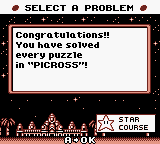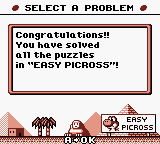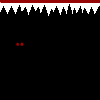I don't think this movie should be accepted in its current form. There are a variety of reasons for this, but the main one is that it's been demonstrated to suboptimal in some rather significant ways, regardless of how you look at it.
1. Using SGB mode. I don't personally care too much about the extra time here, but a frame purist would say it's unnecessary time for the purposes of comparison, and I assume this movie is going to be accepted as a Vault movie.
2. Slow hint-cancelling. Every hint-cancel in the submission loses 30-frames by pressing B instead of R then A.
3. Level mistakes. Holding A at the start of many levels saves one frame by chiseling the top left square followed by immediately moving to an adjacent square (normally, a blank frame is required between inputs). Also, my analysis revealed that the Star 6B level accidentally had some extraneous inputs added that wasted time. This can even be seen in the encode if you watch it at 25% speed, where you can see a square is chiseled, erased, then re-chiseled.
4. If completing all the Time Trial levels would obsolete this movie anyway, maybe we might as well do that now if it wouldn't take too much time. Optimal solutions would need to be found for the additional 64 levels, but I'm already working on a program to do so. I think this is less important than the other 3. Another submission can be made later.
Overall, I think the original movie is a good foundation for a site publication, but it just has a few issues. I would urge Jigwally to request a delay if he's interested in waiting for me to finish my version, which would be co-authored with him, since I'm probably going to be using his solutions for the most part.
----
EDIT: Here is the fastest movie file I've gotten so far. It addresses all of the above issues except for #4:
User movie #64941625601488011. This movie goes through EASY PICROSS and PICROSS, ending input early before the PICROSS completion screen is guaranteed to appear, which already seems to be confirmed as a reasonable endpoint. If Jigwally is willing, it can replace the submission, and I'd be more comfortable with the submission being accepted.
I'm kind of wondering if completing all 64 time trial puzzles should be in a separate submission anyway, since the validity of that being considered full completion is more contentious. It will take some time to add those new puzzle solutions and create a new movie file, so this movie being accepted in the interrim wouldn't necessarily pose a problem, even if does end up ultimately being obsoleted by a "more complete" movie later.

 The phrasing "You have solved every puzzle" suggests this is the end of the main game. It isn't credits, but it's pretty expressive.
I disagree that completing all 64 unique Time Trial puzzles is required for publication because "all unique content" needs to be played. Instead, I think this screen is sufficient to show completing all 192 standard levels is an endpoint.
My draft movie above also ends input early on the premise that reaching this screen is completion. However, there are screens afterwards explaining that Time Trial mode is now unlocked. I will note the screens go on to describe time trial as "the ultimate PICROSS challenge", but I will still maintain that it's fundamentally a side-mode that's not needed for completion.
Side note: "How to play" isn't really content either, it's just an explanation of how to play and a brief demo, but it can be skipped after entering by pressing start. In my opinion, it should not count towards completion either.
The phrasing "You have solved every puzzle" suggests this is the end of the main game. It isn't credits, but it's pretty expressive.
I disagree that completing all 64 unique Time Trial puzzles is required for publication because "all unique content" needs to be played. Instead, I think this screen is sufficient to show completing all 192 standard levels is an endpoint.
My draft movie above also ends input early on the premise that reaching this screen is completion. However, there are screens afterwards explaining that Time Trial mode is now unlocked. I will note the screens go on to describe time trial as "the ultimate PICROSS challenge", but I will still maintain that it's fundamentally a side-mode that's not needed for completion.
Side note: "How to play" isn't really content either, it's just an explanation of how to play and a brief demo, but it can be skipped after entering by pressing start. In my opinion, it should not count towards completion either.









 I think this is a good point: the game clearly delineates between "EASY PICROSS" and "PICROSS". I think they should be considered separate branches for this game, since they have different content.
And to be clear, this is not a trivial game. Firstly, the optimal solutions had to be calculated for each layout, which Jigwally has nicely done in this movie. Secondly, the difference in level lag between soft-resetting and hard-resetting suggests the possibility of significant lag reduction with more research, leading to more deep meta-optimization.
As for full completion... ThunderAxe's definition sounds reasonable enough. I think it's important to keep in mind that not all games have SaveRAM anyway, so artificially restricting the completion of certain puzzles just because completion flags don't show up in the save file seems a bit of a weak argument. On the other hand, you could take a more relative approach and reject it on the basis of completing puzzles in Time Trial without individual acknowledgement being less meaningful than the explicit tracking in the other part of the game. But it's still unique content either way, and would probably present different challenges to the TASer in addition to those presented by the other modes.
I think this is a good point: the game clearly delineates between "EASY PICROSS" and "PICROSS". I think they should be considered separate branches for this game, since they have different content.
And to be clear, this is not a trivial game. Firstly, the optimal solutions had to be calculated for each layout, which Jigwally has nicely done in this movie. Secondly, the difference in level lag between soft-resetting and hard-resetting suggests the possibility of significant lag reduction with more research, leading to more deep meta-optimization.
As for full completion... ThunderAxe's definition sounds reasonable enough. I think it's important to keep in mind that not all games have SaveRAM anyway, so artificially restricting the completion of certain puzzles just because completion flags don't show up in the save file seems a bit of a weak argument. On the other hand, you could take a more relative approach and reject it on the basis of completing puzzles in Time Trial without individual acknowledgement being less meaningful than the explicit tracking in the other part of the game. But it's still unique content either way, and would probably present different challenges to the TASer in addition to those presented by the other modes.
